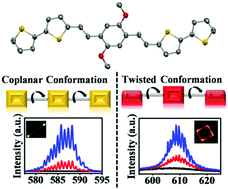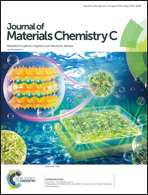The effect of 1D- and 2D-polymorphs on organic single-crystal optoelectronic devices: lasers and field effect transistors†
Abstract
Rational design and fabrication of organic microcrystal polymorphs with controlled molecular-stacking arrangements provides an effective way to optimize the optical and electronic properties, but remains challenging owing to weak van der Waals’ intermolecular interactions associated with the kinetic process of crystal growth. In this paper, we synthesized a novel compound, 1,4-dimethoxy-2,5-di[bithiophenestyryl]benzene (TPDSB), which combines the high optical-gain of the oligomeric phenylene vinylene (OPV) core-moiety with enhanced charge transportation offered by bithiophene end-groups. Controlled fabrication of one-dimensional microwires (1D-MWs) and two-dimensional microdisks (2D-MDs) was achieved by controlling the growth temperature: 1D-MWs at 30 °C as a kinetically favored morphology and 2D-MDs at 2 °C as a thermodynamically stable product. We found that though both 1D-MWs and 2D-MDs belong to the monoclinic phase, their different molecular packing arrangements caused by different molecular conformations result in distinctly different optical and electrical properties. In particular, well-faceted 1D-MWs and 2D-MDs can function as yellow-emissive Fabry–Perot (FP) and red-emissive whispering-gallery-mode (WGM) microlasers, respectively. Furthermore, single-crystal data reveal that TPDSB molecules adopt a planar conformation in 1D-MWs with relatively loose molecular-packing into rolled π-stacks, while twist molecules in 2D-MDs exhibit tight molecular-packing into slipped π-stacks. This makes 2D-MDs have a higher PL quantum yield (Φ), a lower lasing threshold and a higher carrier mobility than 1D-MWs. Our results demonstrated that these easily solution-processed organic microcrystal polymorphs might be optimized on the way to realizing electrically driven organic lasers.

- This article is part of the themed collection: 2018 Journal of Materials Chemistry C HOT Papers


 Please wait while we load your content...
Please wait while we load your content...